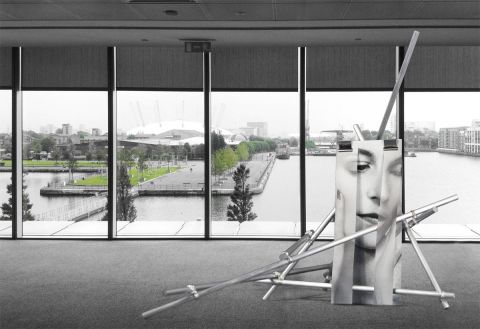Here’s my third and final version of Not at Clifford Chance.
For the first time I’ve used one set of images but then split them four-ways to increase complexity and disjuncture without making them so busy they undermine the sculpture itself. Rather than applying different collage techniques to each panel it proved better to restrict myself to two approaches — to accrete and to slice in this case.
I rotated the sculpture and re-positioned (embedded) the collages within it to ensure plenty of interruption to the picture plane by the rods.
Last time, I questioned what was added marrying collages with sculpture — would they be just as effective mounted direct onto the wall? For me, the answer is the rods definitely add disruption. I don’t think Not at Clifford Chance interrupts the picture plane any more effectively than the more uniform approach of In the shadow of her gaze no.2, but overall the piece is more aggressive and assertive thanks to the increased scale of the collages, the more abrupt physicality of the scaffold poles, and the greater architectural form of the construction itself.
All-in-all, I think this is the most successful version of Not at Clifford Chance.
I tried to test the impact of mirrors but found it pretty impractical. It’s hard to get one’s eye into the correct perspective, let alone the camera, and it’s virtually impossible to photograph without inadvertently adding myself and my surroundings. However, so far, I know the following about mirrors:
Mirrors top and bottom in the horizontal plane create an endless chasm in which to fall or float upwards.
A similar effective effect results if two mirrors are placed opposite each other in a vertical plane but the impact is less successful. It simply results in replication, not a pit to topple into.
Abutting a mirror to the sculpture so edges touch creates a seamless repetition – a duplicate sculpture.
Large vertical mirrors pull the viewer in too abruptly and definitively, whereas smaller slivers of refraction are more subtle. One minute part of you is pulled in and the next it’s gone as your position shifts.







